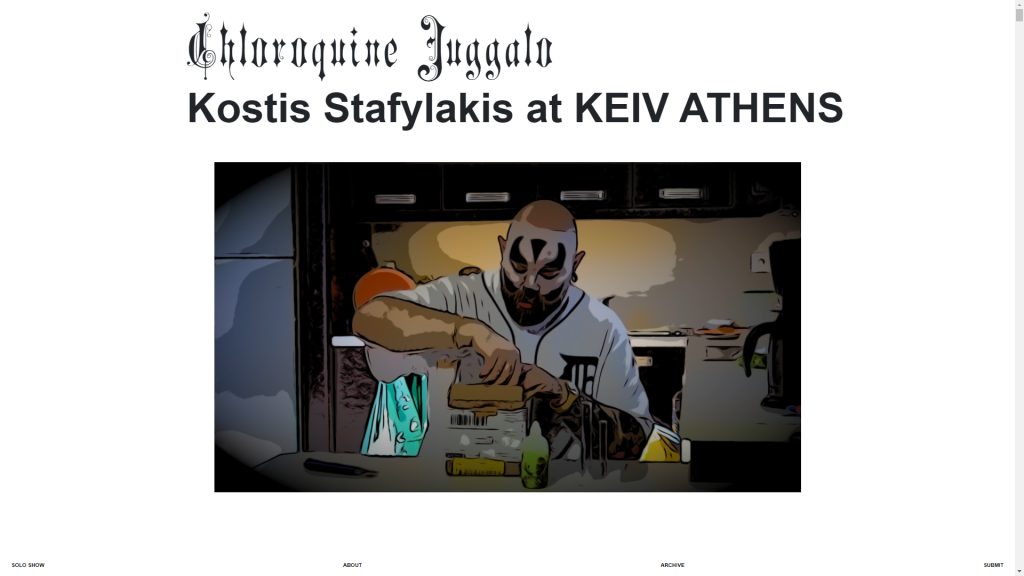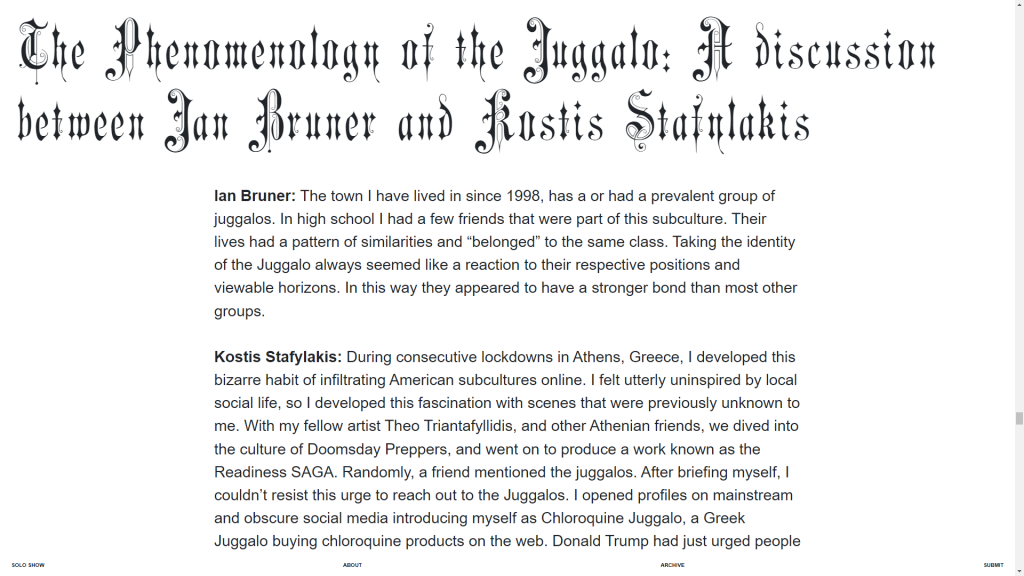THE PHENOMENOLOGY OF THE JUGGALO: iAN BRUNER & kOSTIS STAFYLAKIS FOR SOLOSHOW.ONLINE

Soloshow.online presents the Chloroquine Juggalo show at KEIV Athens and Kostis Stafylakis discusses with artist and curator Ian Bruner on Juggalo culture, monstrification, horror & politics.
An excerpt from Ian Bruner’s dicussion with Kostis Stafylakis:
IB: They are like a response to class and repression, a reaction to penury and immobility. A group as a residue of American society and ideology, the chemical run off bristling with a destructive force given to them through what is taken from them, a dialectical potentiality.
KS: They seem to genuinely forge some bizarro version of Americana, though the particularities of their social experience of neglect, scorn, stigmatization, along with elusive memories of abuse, function as a social wound that “speaks” and produces some type of social empathy that can only be expressed indirectly, as a slang, through a certain codification that salvages the trauma. The “wicked clown love” gestures, the mmfwcl greeting that’s become a popular hashtag, the flexing of the hatchet-man necklace, and similar semantics are rituals of bonding and emancipation. I think we shouldn’t lose sight of this dimension when analyzing their attraction to fantasy violence. The exacerbated violence of chainsaw avengers and wicked ringmasters isn’t without a symbolic framework. This exacerbation operates within the hard limits of a symbolic framework of minimum social empathy – and those limits are frequently confirmed and occasionally trespassed. At the same time, their personal, social, ideological ambiguities seem to horizontally traverse the totality of American social/political life. They march against wife-beaters but they may revert to sexist imagery, they are against bigotry but they galvanize a disproportionate fright with “pedophiles” (who they tend to discover everywhere). This “anti-pedo” rhetoric preceded the influence of recent conspiracy theories such as QAnon. I was rather surprised to witness Juggalos accusing other Juggalos on TikTok of being pedophiles. Occasionally, the extremity of fantasy violence is counterbalanced with some performance of righteousness. Such ambivalences, or incoherencies, pertain to a crucial dimension of the political, we shouldn’t lightheartedly dismiss. They testify that the idea of emancipation is always “partial”, temporal, and “contingently” articulated.
IB: Yeah I think this is a big part of the draw to that life. A sense of disenfranchisement and the weight and impossibility of upward movement. So I think the response of viewing the world through horror is a sort of psychological stage of renewing oneself, through a process of destruction which then leaves a space in which one can attempt to rebuild. They have a strong cohesion though that many groups don’t have, which is needed for actual revolution.
KS: There is a dark zone of ideology, I guess specific to the American Rust Belt and extending to the deep suburbia, and to the redneck culture – a rhizomatic radicalization which is almost impossible to properly chart. While contacting people as Chloroquine Juggalo, I came across some really puzzling phenomena. I discovered some cases of right-wing juggalos, trumpists and white-suprematists, who circulated offensive, racist, and misogynist memes while often posting “Southern pride” insignia. I actually dox one in the main video of the show. He is very open about it anyway. And then I also discovered a beautiful disjunction: the Redneck Revolt organization which supported the 2017 Juggalo March, and strives to bring the “red” back in Redneck. RR is a pro-gun organization, engaging in tactical training, self-identifying as socialist, anti-racist, and anti-fascist. On TikTok, I dueted a popular “Marching against the Alt-Right” video by a member of Redneck Revolt that was frequently mocked by Trump supporters. I hope I incidentally contributed to the re-circulation of the video, enabling new adaptations. My TikTok activity as Chloroquine Juggalo plays on a tablet adjusted on a sculpture with guns and a green skull, that I named “Redneck Revolt: New Horror”. It’s difficult, and perhaps inappropriate, to critically analyze such puzzling characteristics through universalizing abstractions. In parallel, we should take into account the gradual shift of Juggalo culture towards a more intersectional restructuring. The social body that participated in 2017 Juggalo March testifies for that. Take a look at the Struggalo coalition and the work of artist Rachel Paul and the feminist juggalo group Lette’s Respect. Greek artist Elias Kafouros, who visited the show at Keiv, drew my attention to the Heyoka, the Native American Sioux legacy of a clan of sacred clowns that would periodically interrupt the life of community, destabilizing embedded hierarchies through provocative satire, doing things differently. A quick search shows that a good number of Juggalos online are aware of this cultural overlapping, and mention it, calling Shaggy 2 Dope’s Native American descent into mind. Of course, this is also the cross-cultural topos personified by the mythical figure of Momus, the God of satire, mockery, and unfair criticism. In a text about to be published by the Athens Biennale, I coined the term “mometics” to designate both a field of research into the dialectics between Momus and the Mime, and an artistic legacy that demands rethinking.
Read the entire presentation and discussion on soloshow.online here
